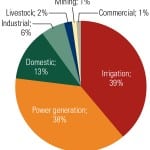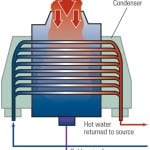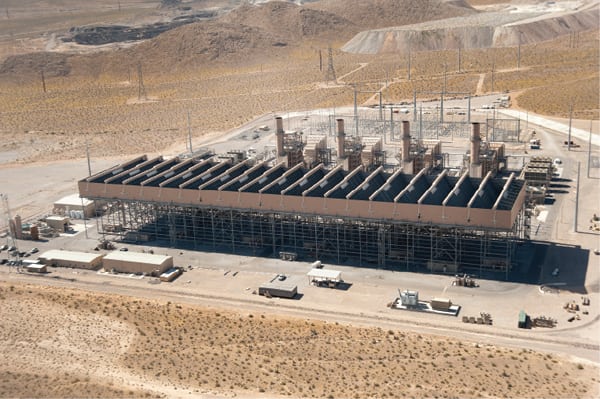 |
| Courtesy: NV Energy |
Drought and competing uses for water continue to challenge power plant operators worldwide. In response, innovative approaches for reducing water use are being explored from South Africa to China.
Water is essential to thermoelectric power generation, but drought and growing competition for water from myriad other uses can have major effects inside the power plant, impacting operations and, ultimately, reliability.
Consider these recent examples. Dominion’s Millstone nuclear plant in Connecticut had to shut down a reactor last August because the water it drew from Long Island Sound was too warm. In response, Dominion asked the Nuclear Regulatory Commission in May this year for permission to use the seawater at 80F, up from 75F. A decision is expected in 2014, following a technical review.
Also last summer, Exelon’s two-unit Braidwood nuclear station near Chicago needed special permission to operate after the temperature in its cooling water pond rose to 102F, four degrees above its normal limit.
Elsewhere in the U.S., low water levels on parts of the Mississippi stalled coal barges headed to power plants, forcing the U.S. Army Corps of Engineers to dredge channels to maintain commercial barge traffic.
Droughts in Europe in 2003 and 2006 forced the shutdown or curtailment of a number of thermoelectric units. During the 2003 drought, for example, French nuclear operators had to shut down as much as 25% of the country’s nuclear fleet.
Drought conditions affect hydroelectric generation, too. As POWERnews reported in March, Brazil, which sources 67% of its power from hydro, has suffered the worst drought in 50 years, causing dams in the northeast to fall to 32% of capacity. Both power generators and electricity consumers have seen price spikes as a result.
One of the most dramatic examples in the U.S. is the visibly lower water levels in Lake Mead and Lake Powell, along the Colorado River. The light-colored rock in this issue’s cover photo shows how far below historic levels Lake Mead—which supplies water for generation at the iconic Hoover Dam near Las Vegas, Nev.—was in November 2010.
As of mid-May, Lake Powell storage behind Glen Canyon Dam in Utah was 11,396 thousand acre-feet, around 47% of normal. Lake Mead storage was 12,887 thousand acre-feet, or 49% of normal. The April–July forecast for water flows along the Colorado River was 3.00 million acre-feet, or around 42% of average. Despite the low levels, the U.S. Bureau of Reclamation (USBR), which operates Glen Canyon and Hoover Dams, has been able to meet its contractual obligations. However, Ron Smith, USBR acting power manager for the Lower Colorado Region, explained that lower water levels mean lower pressure and less generation potential, so the units have been derated further.
To help address the impacts of lower lake level on generation at Hoover Dam, the USBR has installed a “wide-head” turbine (sometimes called a “low-head” turbine) on the Nevada side of the dam. N8, as it is called, is rated at 130 MW but is currently derated to 115 based on the lake level. “It’s been a very successful installation,” Smith told POWER, “and the plan is to install more,” because this type of turbine enables generation across a wider range of rated capacity, making for more efficient generation under low-head conditions.
Growing Water Scarcity
Drought can seem extreme in the U.S., but a 2011 report from the National Energy Technology Laboratory (NETL), “Reducing Freshwater Consumption at Coal-Fired Power Plants: Approaches Used Outside the United States,” says that water-short areas can be more widespread in countries such as China, South Africa, and Australia. China, for example, ranks as the world’s third-driest country. The NETL report says that by 2030, China’s annual water demand could reach 216 trillion gallons, one-third of it for industrial demand driven by thermal power generation. Water supplies in China for 2030 are estimated at roughly 164 trillion gallons. As a result, demand is on track to exceed supply by about 52 trillion gallons in 2030. By comparison, total water withdrawals in the U.S. in 2005 were 150 trillion gallons.
Reducing water consumption at all types of steam power plants has been a worldwide concern for years, sparking a wide range of efforts to cut water use while meeting growing demand for electricity (see table).
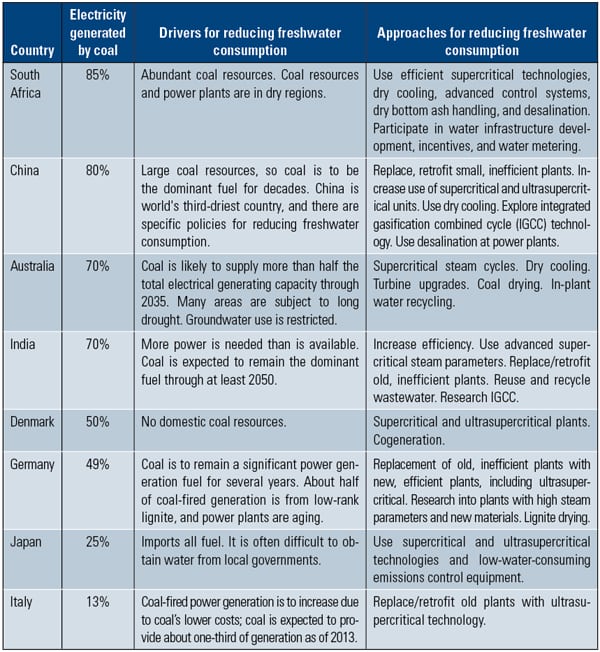 |
|
Global investment. Efficiency improvements along with supercritical and ultrasupercritical technologies are gaining favor in countries that face water constraints. Source: NETL |
Steam-electric plants in the U.S. account for around 40% of the nation’s freshwater withdrawals. Much of that water is returned to its source, however. That leaves actual net consumption for power generation at around 3% of the nation’s overall freshwater consumption.
Much of the net consumption stems from evaporation and drift losses from cooling systems. Research published by the Electric Power Research Institute (EPRI) suggests that water use rates at plants with closed-cycle, wet cooling systems might not be sustainable in some locations as thermal discharges from once-through cooling face increasing regulatory scrutiny. Some plants already operate under water use restrictions or are being required to install water-conserving technologies. What’s more, siting new capacity can be difficult due to water supply constraints.
The net result is that cooling and water treatment technologies to reduce water consumption, the use of reclaimed water, and the reuse of internal water and even wastewater streams are gaining traction in the generation sector. (See also “New Coal Plant Technologies Will Demand More Water” in the POWER archives at powermag.com.)
For example, NV Energy’s Walter M. Higgins Generating Station in southern Nevada (Figure 1 and the photo at the top of this story) is a 530-MW combined cycle power plant that uses two Westinghouse 501FD combustion turbines and an Alstom STF30C steam turbine. The plant entered service in 2004 and, unlike conventional power plants, uses a six-story-high dry cooling system. Similar to a car radiator, 40 fans (each 34 feet in diameter) condense the steam and cool plant equipment. The plant uses 14 gallons of water for each megawatt produced. By contrast, a conventionally cooled power plant of similar size might use as much as 650 gallons of water per megawatt. The Higgins Station also saves water by reusing “gray water” from three nearby casinos.
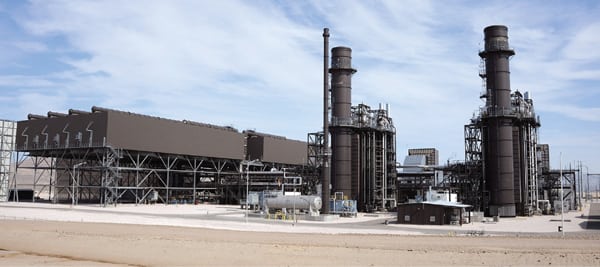 |
| 1. Fourteen gallons of water. NV Energy’s 530-MW Walter M. Higgins Generating Station in Nevada uses a dry-cooling system that enables it to use 14 gallons of water for each megawatt of power produced. A conventionally cooled power plant might use up to 650 gallons. Courtesy: NV Energy |
NV Energy is one of the most experienced generators in the U.S. when it comes to dry cooling. Its 1,102-MW Chuck Lenzie Station, 30 miles north of Las Vegas, ranks as one of North America’s largest dry-cooled power plants. The plant includes two side-by-side power production blocks outfitted with GE 7FA combustion turbines. The exhaust from the four turbines produces steam for two GE D-11 steam turbines. As part of its water use strategy, the Lenzie station also uses a water clarifier system that recaptures and recycles about 75% of the process water.
Operational and Economic Consequences
One of the biggest effects that drought has imposed on electricity production stemmed from a 2001 drought in California and the Pacific Northwest. Although power outages were largely avoided, significant financial impacts were tallied. For example, the Northwest Power and Conservation Council estimated in 2005 that the total regional economic impacts totaled between $2.5 billion and $6 billion.
The southeastern U.S. drought of 2007–2008 posed a risk to baseload thermoelectric generation facilities. Tennessee Valley Authority, for example, had to shut its Browns Ferry nuclear generating plant temporarily, and generation was reduced all across the region during August 2007. Low water levels led to a rise in water temperature, which began to bump up against discharge temperature limits set in operating licenses.
A 2011 report from Argonne National Laboratory, “Analysis of Drought Impacts on Electricity Production in the Western and Texas Interconnections of the United States,” noted that hydro generation in general is far more significantly affected by drought than thermoelectric generation. It explained that hydro generation varies widely, depending upon hydrological conditions. In fact, reports on droughts in the West in the mid-1970s and in 2001 indicated little significant impact on thermoelectric generation. The greater risk, at least in California and the Pacific Northwest, stemmed from reliance on hydroelectric generation.
Three other studies from Argonne looked at potential impacts of drought on power generation. The first looked at cooling-water intake heights as an indicator of drought risk for thermoelectric power plants. Of some 423 plant analyzed, 43% were identified as having cooling-water intake heights less than 10 feet below the typical water level of their water source. The second study looked at U.S. coal plants and ranked them by their vulnerability on the basis of 18 different water supply and demand-related indicators. Of the 580 plants evaluated, 60% (representing roughly 90% of total coal generating capacity) were said to be vulnerable on the basis of either supply- or demand-related criteria.
A third study, published in 2009, modeled a drought scenario in the western U.S. to estimate the impact on electricity prices and CO2 emissions. The model simulated supply to match historical hourly load data. The results showed increases in electricity prices ranging from 4% to 35%, depending on the month and year. The researchers also estimated a 5% increase in CO2 emissions in the drought scenario, resulting from an increase in natural gas generation to make up for lost hydroelectric generation.
A 2010 EPRI report, “Freshwater Needs for Thermoelectric Generation,” said the largest demand for water in thermoelectric plants is cooling water for condensing steam. The process of thermoelectric power generation is well known, but the basics are worth reviewing to focus more narrowly on how water is used. Thermoelectric generation relies on a fuel source (fossil, nuclear, or biomass) to heat water to steam that is used to drive a turbine. Steam exhausted from the turbine is condensed and recycled to a steam generator or boiler. This steam condensation typically takes place in a shell-and-tube heat exchanger known as a condenser. The steam is condensed by the flow of cooling water through tube bundles that are located within the condenser.
Cooling System Options
In general, three types of cooling system designs are used for thermoelectric power plants: once-through, wet recirculating, and dry. In once-through systems, the cooling water is withdrawn from a lake, river, or ocean. This water then is warmed as it passes through the power plant and finally is discharged back to the water body after having passed through the surface condenser. As a result, plants outfitted with once-through cooling water systems have relatively high water withdrawal but low overall water consumption.
Two basic technologies are used to support wet recirculating cooling systems, wet cooling towers and cooling ponds. The most common type of recirculating system uses wet cooling towers to dissipate heat from the cooling water to the atmosphere. In wet recirculating systems, warm cooling water is pumped from the steam condenser to a cooling tower. There, heat from the warm water is transferred to air flowing through the cooling tower. In the process, a portion of the warm water evaporates and forms the commonly observed water vapor plume. The cooled water then is recycled back to the condenser. Because of evaporative losses, some of the cooling water needs to be discharged from the system—a process known as blowdown—to prevent the buildup of minerals and sediment that could adversely affect performance.
For a wet recirculating system, only makeup water needs to be withdrawn from the local water body to replace water lost through evaporation and blowdown. As a result, plants equipped with wet recirculating systems have relatively low water withdrawal, but high water consumption, compared to once-through systems.
Wet cooling towers follow two basic designs: mechanical draft and natural draft. Mechanical draft towers use a fan to move air through the tower. By contrast, natural draft towers rely on the difference in air density between the warm air in the tower and the cooler ambient air outside the tower to draw air up through the tower. In both designs, warm cooling water is discharged into the tower for direct contact with the ambient air. A cooling pond serves the same purpose as a wet cooling tower, but it relies on natural conduction/convection heat transfer from the water to the atmosphere as well as evaporation to cool the recirculating water.
Dry cooling systems can use either a direct or indirect air-cooling process. In direct dry cooling, the turbine exhaust steam flows through tubes of an air-cooled condenser (ACC). The steam is cooled via conductive heat transfer using ambient air that is blown by fans across the tubes. As a result, cooling water is not used in this system. For indirect dry cooling, a conventional water-cooled surface condenser is used to condense the turbine exhaust steam. However, a dry cooling tower, similar to an ACC, transfers heat from the water to the air via conduction. As a result, no evaporative loss of cooling water occurs. What’s more, water withdrawal and consumption both are minimal.
In the U.S., existing thermoelectric power plants use all of these types of systems, with estimates suggesting that around 43% of generating capacity uses once-through cooling, 42% wet recirculating, 0.9% dry cooling, and 14% cooling ponds (Figure 2).
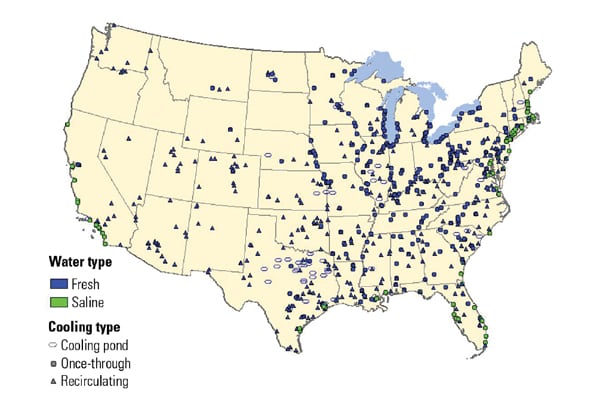 |
| 2. Cooling systems by technology and water source. Estimates suggest that 42.7% of generating capacity uses once-through cooling, 41.9% relies on wet recirculating systems, 0.9% employs dry cooling technology, and 14.5% depends on cooling ponds. Source: NETL |
Plant type is an important factor in the amount of water required. Of the fossil-fueled plants, coal units have the highest heat rates (or lowest efficiencies), as well as the highest requirements for water over and above that for condenser cooling, due to the in-plant power and water requirements for coal pulverization, flue gas scrubbing, and ash handling.
Simple cycle gas turbine plants have a condenser cooling load of zero, as a result of their design. For combined cycle plants, anywhere from one-third to one-half of the electric power output is generated with the steam portion of the power cycle. In this case, the unit’s condenser cooling requirements correspond to the output of the steam cycle. However, virtually all combustion turbine plants have additional water requirements, including gas turbine inlet air cooling, steam or water injection in the gas turbine compressor inlet, and, in the case of integrated gasification combined cycle plants, water for the gasification process.
Some renewable energy plants, such as solar photovoltaic and wind, have no steam condenser cooling requirements. However, solar thermal and biofuel-fired power plants typically use Rankine steam cycles similar to the steam cycles at fossil plants. What’s more, solar plants almost always require water for collector surface cleaning.
Rethinking Water Use
In February 2011 and June 2012, EPRI issued requests for information to invite what it called early-stage, out-of-the-box, and innovative ideas and technologies to reduce freshwater use in power plants. Between 2011 and 2012, more than 100 proposals were submitted. This year, a possible joint solicitation between EPRI and the National Science Foundation (NSF) aimed at advancing water-conserving cooling technologies is planned. Winning proposals will be funded by both organizations through collaborative but independent funding approaches, as NSF awards grants and EPRI awards contracts.
One initiative, from the Gas Technology Institute (GTI) and partners, suggests developing an advanced cooling tower fill to enable evaporative cooling of hot water from the steam condenser at near dew point temperature. This approach is based on a method of evaporative cooling called M-Cycle that allows cooling water to be cooled below the ambient wet-bulb temperature (the current limit of cooling temperature), or even to the dew point temperature of the incoming air, with substantially lower water and energy consumption requirements.
To achieve this low cooling temperature, an airflow/tower fill arrangement is proposed. Incoming airflow is drawn through dry passages arranged in the fill to be indirectly precooled by evaporating water. The GTI team says this process differs from conventional cooling tower fills, which have wet evaporation channels only. The advanced cooling tower fills have dry channels between the evaporation channels to allow incoming ambient air to be precooled by evaporation to about dew point temperature before the air turns into adjacent wet channels to remove heat from the water. The precooled air enables evaporation at a much lower temperature, resulting in cooled water temperature close to dew point temperature and below the ambient air wet-bulb temperature.
The lower temperatures and decreased evaporative losses compared to conventional cooling towers result in 15% to 20% less cooling water and makeup water usage, according to the GTI.
Based on modeling results, EPRI said it expects to initiate engineering, fabrication, and proof-of-concept evaluation of an experimental section of cooling tower fill this year, in collaboration with the GTI and a commercial manufacturer. Parallel engineering and economic modeling will be done to compare cost and performance for the advanced fill system and a conventional cooling tower in both retrofit and new construction applications at 500-MW plants. This will include assessing possible heat rate improvements associated with operation at lower turbine back-pressure. Results from these activities are expected to support the launch of field demonstration projects by the end of 2014.
Global Water Initiatives
Efforts are also under way outside of North America to address water consumption issues. NETL said that countries aggressively implementing dry cooling technology include China, South Africa, and Australia.
China has adopted dry cooling for many new plants. The Huaneng Qinling Power Plant provides an example of how dry cooling is being used in China. In Shanxi Province, water shortages are hindering development of the central Shaanxi plain, consequently, the 1,300-MW Huaneng Qinling Power Plant uses an indirect dry cooling system. The technology relies on a traditional steam surface or jet condenser and a circulating water system to transfer waste heat to the natural draft concrete cooling towers using air-cooled heat exchanger bundles. The system also uses a two-level cooling arrangement designed to increase cooling efficiency. This two-level arrangement was also used at the 1,320-MW Huaneng Shanxi ZuoQuan Power Plant. The cost of the cooling system is estimated at $33 million.
South Africa’s state-owned electric utility, Eskom, has implemented dry cooling technology on power stations, where feasible, despite the loss of efficiency, which may be on the order of 1% to 1.5%, as at the 750-MW Kogan Station in Australia, which also uses dry cooling. Eskom operates one of the world’s largest indirect dry-cooled power plants (the 4,116-MW Kendal plant) and one of the largest direct dry-cooled plants (the six-unit, 3,600-MW Matimba Plant, see Figure 3).
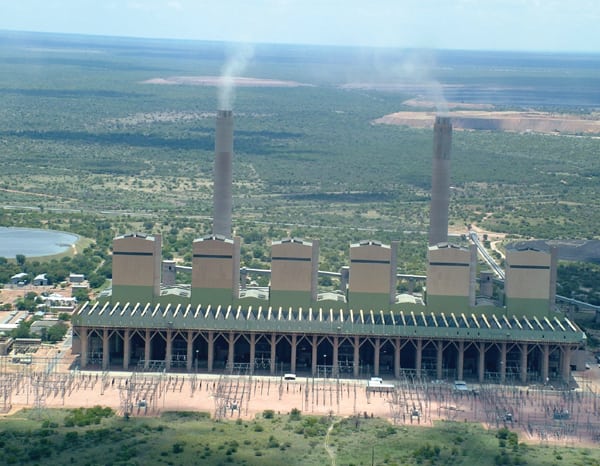 |
| 3. Air-cooled in South Africa. Eskom’s six-unit, 3,600-MW Matimba Station uses direct closed-circuit cooling technology, which enables it to use 0.1 liters of water per kWh produced. Courtesy: Eskom |
The Kendal Power Station uses an indirect dry cooling system. In this system, water from a standard condenser is circulated to the tower, where it enters a series of heat-exchange elements at the base. Air enters the bottom periphery of the tower, passing over the heat-exchange elements. Inside the tower, the heated air rises, pulling in more cooled air. Fans are not required. Water consumption at the Kendal Plant is about 0.08 liters per kWh.
The Matimba Power Plant uses a direct closed-circuit cooling technology. Water consumption is about 0.1 liters per kWh. That compares with about 1.9 liters on average for wet-cooled stations. The choice of dry-cooled technology for Matimba was largely influenced by a scarcity of water in the area.
In Australia, dry cooling is used in two Queensland power stations (Millmerran and Kogan Creek). The 850-MW supercritical Millmerran plant opened in 2003 and is one of the most energy-efficient plants in Australia. It uses air cooling to condense steam from the turbine exhaust and consumes 90% less water than conventional coal-fired power projects. Recycled wastewater from a nearby sewage treatment plant is treated on site and used as makeup water. All runoff water is contained on site and reused. The 750-MW supercritical Kogan Creek power plant in Queensland began operations in 2007. It has an air-cooled condenser that uses up to 90% less water than conventional plants.
Drought conditions are only one factor driving worldwide interest in reducing water consumption for electric power generation. Competing uses make it almost imperative for the sector to rethink how it uses water and to take steps to reduce its use as much as possible.
— David Wagman is executive editor of POWER.







